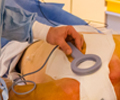Tag Archives: cardiac resynchronisation therapy
February 2025 Br J Cardiol 2025;32:23–5 doi:10.5837/bjc.2025.007
Low prevalence of CRT upgrade in patients with significant RV pacing: 10-year real-world data in a UK DGH
Thet Y Hnin, Paresh A Mehta
| Full textJuly 2022 Br J Cardiol 2022;29(suppl 2):S13–S16 doi:10.5837/bjc.2022.s08
Guidance on lifestyle, rehabilitation and devices in heart failure patients
Savvas Hadjiphilippou, Rebecca Lane
| Full textJanuary 2022 Br J Cardiol 2022;29:40 doi:10.5837/bjc.2022.006
Correspondence: Improving DVLA advice upon discharge after cardiac device implantation
Arsalan Khalil, Tamara Naneishvili, Abigail Mayo-Evans, James Glancy
| Full text
January 2019 Br J Cardiol 2019;26:14–8 doi:10.5837/bjc.2019.002
A survey of post-cardiac rhythm device implantation: movement and mobilisation advice in the UK
George Collins, Sarah Hamill, Catherine Laventure, Stuart Newell, Brian Gordon
| Full text
October 2018 Br J Cardiol 2018;25(suppl 3):S20–S24 doi:10.5837/bjc.2018.s15
Pacing supplement: Drugs with devices in the management of heart failure
Balrik Singh Kailey, Christopher Allen, Badrinathan Chandrasekaran
| Full text
December 2015 Br J Cardiol 2015;22:155 doi:10.5837/bjc.2015.041
Latest NICE guidelines on CRT and ICD devices in heart failure may significantly increase implant rates
Thabo Mahendiran, Oliver E Gosling, Judith Newton, Dawn Giblett, Dan McKenzie, Mark Dayer
| Full text
December 2015 Br J Cardiol 2015;22:134–5 doi:10.5837/bjc.2015.039
Impact of latest NICE guidelines on CRT and ICD implant rates
Andrew J Turley
| Full text


